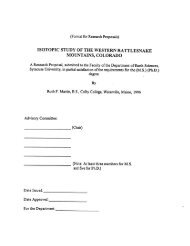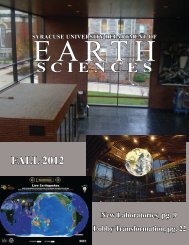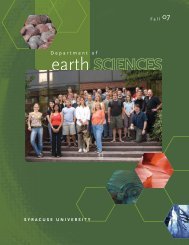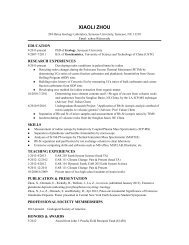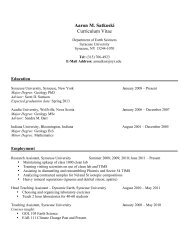alumni reception - Syracuse Universe Department of Earth Sciences ...
alumni reception - Syracuse Universe Department of Earth Sciences ...
alumni reception - Syracuse Universe Department of Earth Sciences ...
Create successful ePaper yourself
Turn your PDF publications into a flip-book with our unique Google optimized e-Paper software.
the East Pacific Rise. We are also focusing on the<br />
details <strong>of</strong> faulting in basaltic materials, fault control<br />
<strong>of</strong> hydrothermal systems, and parameters that control<br />
basaltic flow morphologies. One <strong>of</strong> the highlights <strong>of</strong><br />
the year was a fieldtrip around Iceland for our group<br />
with co-investigator Dr. Bob Varga (Pomona College),<br />
and undergraduates Yexary Rodriquez and Amanda<br />
Loman.<br />
In the coming year, we look forward to<br />
continuing these studies and to the publication <strong>of</strong> the<br />
results <strong>of</strong> recently completed work. Aleece (MS) and<br />
Drew (PhD) will finish their degree work and move on<br />
to the next stages <strong>of</strong> their careers. Matt Kissane (BS’<br />
2010 from Union College) will be joining our group<br />
in the fall after spending some time in the field in<br />
Iceland.<br />
Laura Lautz<br />
Research in the Lautz group has ramped up<br />
this past year with the addition <strong>of</strong> three new graduate<br />
students who began their programs in Fall 2009.<br />
Martin Briggs (PhD) is doing research on heat tracing<br />
in hydrologic systems, with funding from my NSF<br />
CAREER grant. He has developed new methods<br />
using fiber optic Distributed Temperature Sensing<br />
(DTS). We wrap bend-insensitive fiber optic cable<br />
around a 2-inch rod, which is then installed in stream<br />
sediments. Using the wrapped cable, we can measure<br />
temperatures instantaneously every 1.5 cm along the<br />
rod, taking measurements in vertical pr<strong>of</strong>ile every<br />
few minutes for weeks at a time. These detailed<br />
temperature pr<strong>of</strong>iles are then used to model rates <strong>of</strong><br />
water flow through the subsurface. Marty is also using<br />
a new “smart” tracer, resazurin, to measure microbial<br />
activity in streams and their streambeds. Marty’s first<br />
manuscript for his PhD is currently in review with<br />
Hydrological Processes.<br />
Tim Daniluk (MS) and Ryan Gordon (MS)<br />
are doing research on how stream restoration projects<br />
affect stream-groundwater interaction around<br />
restoration structures, with funding from NSF that<br />
started in January 2010. Billions <strong>of</strong> dollars are<br />
spent annually on stream restoration in the U.S., but<br />
assessments <strong>of</strong> impacts on subsurface hydrology<br />
are practically absent. Tim and Ryan will use a<br />
combination <strong>of</strong> heat and geochemical tracing to<br />
determine the degree to which restoration projects<br />
induce rapid stream-groundwater interaction. They<br />
will also assess associated impacts on physical,<br />
chemical, and thermal patterns in streambeds.<br />
Preliminary results <strong>of</strong> their work were presented<br />
at the EGU (European Geosciences Union) annual<br />
conference in Vienna in May.<br />
Laura and Sharon Lautz hiking – twin brother Aidan<br />
was also along only on Dad’s back!<br />
I continue to work on the broad research areas<br />
<strong>of</strong> heat tracing in hydrologic systems and streamgroundwater<br />
interactions by mentoring my graduate<br />
students on the aforementioned projects and working<br />
with colleagues. I recently completed a modeling<br />
study <strong>of</strong> how non-ideal field conditions impact the<br />
accuracy <strong>of</strong> heat tracing, work that appears in the<br />
journal Water Resources Research. I also have several<br />
papers co-authored with graduate students in 2010,<br />
including a paper co-authored by <strong>Syracuse</strong> alum<br />
Nate Kranes (MS ‘07) that appears in Hydrological<br />
Processes.<br />
Cathryn Newton<br />
After eight years as Dean <strong>of</strong> the College <strong>of</strong><br />
Arts and <strong>Sciences</strong>, and a total <strong>of</strong> 16 consecutive years<br />
in administration, it is thrilling to have the chance<br />
to write and to teach as a full-time faculty member<br />
again. I continue to teach in the Renée Crown<br />
University Honors Program (as I did as dean). For<br />
four iterations, I have co-developed and co-taught<br />
a course with Honors Director and Philosophy<br />
pr<strong>of</strong>essor Samuel Gorovitz, “Linked Lenses: Science,<br />
Philosophy, and the Pursuit <strong>of</strong> Knowledge”. The<br />
fourteen students in the course do serious readings<br />
in both science and philosophy – Gould, Margulis,



